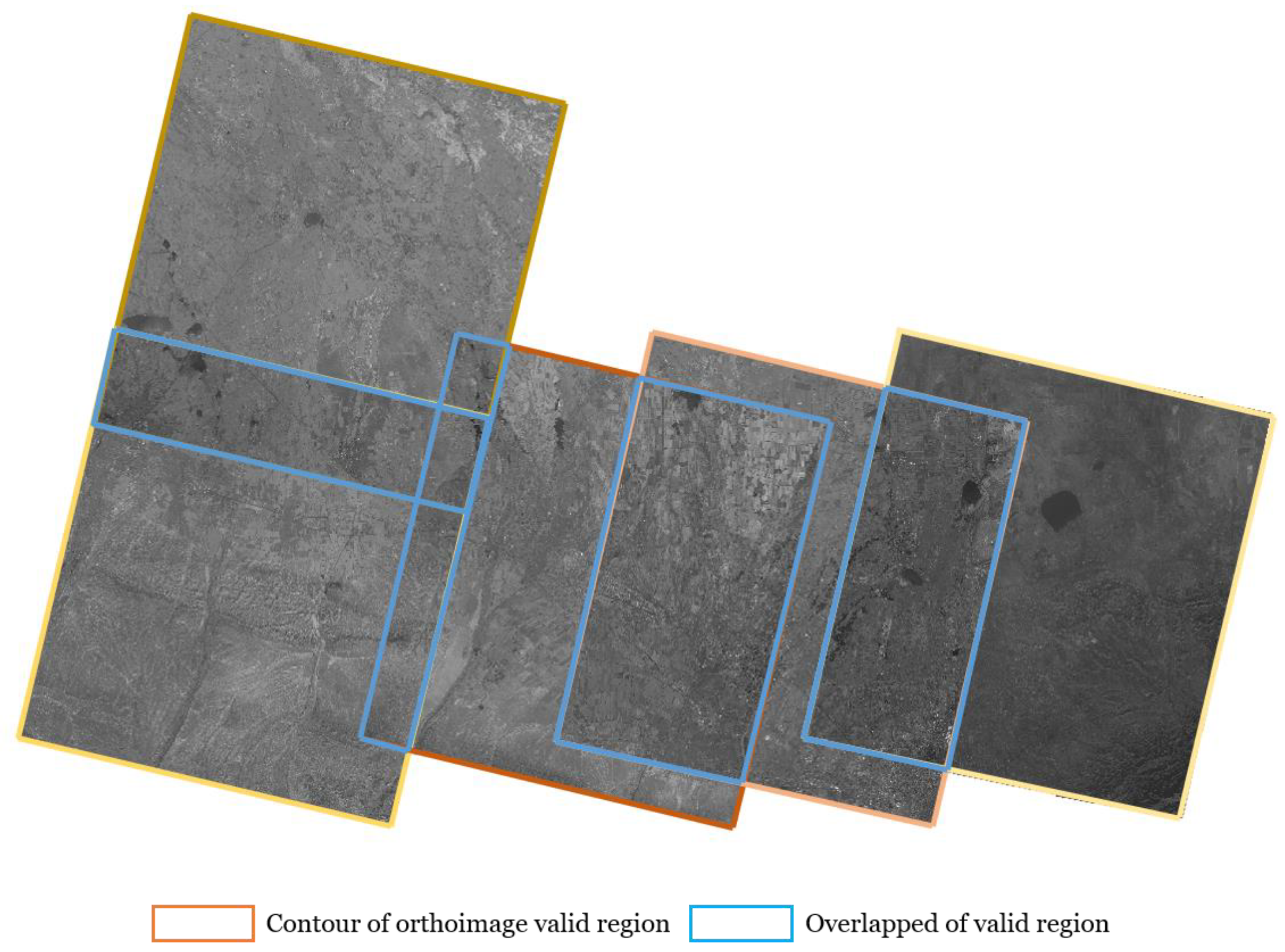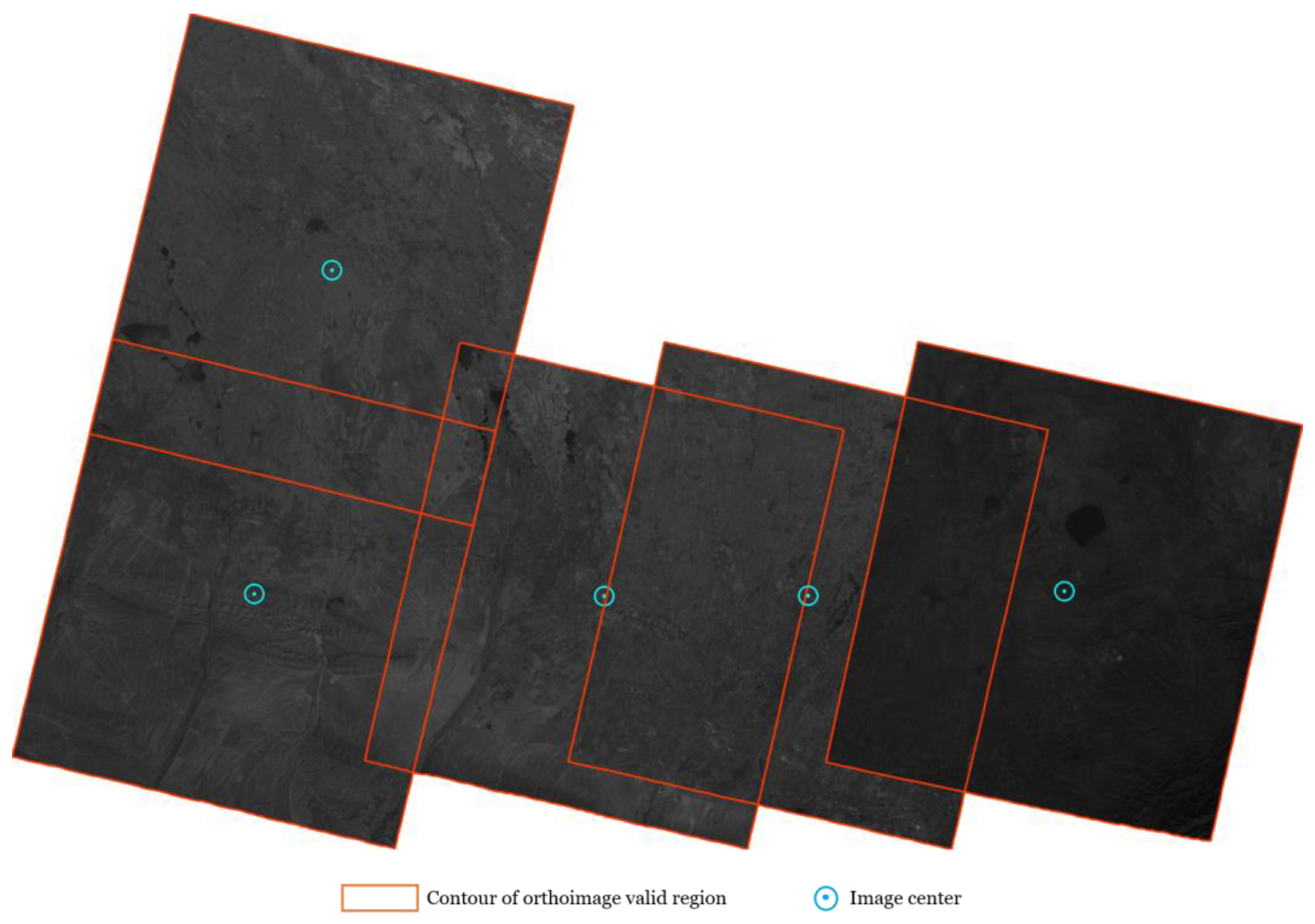Voronoi Centerline-Based Seamline Network Generation Method
Abstract
:1. Introduction
2. Materials and Methods
2.1. Voronoi-Based Centerline Extraction
| Algorithm 1 VOA Densification |
| Input: VOA, Distmin |
| Output: Denified VOA |
| 1: for each vector ∈VOA (vector0, vector1 … vectorn) |
| 2: if Lengh (vectori) < Distmin then |
| 3: n = Lengh (Vectori)/Distmin; |
| 4: for each j ∈ [0,n) |
| 5: Pointj (j * VectoriX/n, j * VectoriY/n); |
| 6: Vectori.Insert (Pointj); |
| 7: endfor |
| 8: endif |
| 9: endfor |
2.2. EMP Segmentation
3. Results
3.1. Preparation for Experiments
3.2. Result
4. Discussion
Extreme Testing
5. Conclusions
Author Contributions
Funding
Data Availability Statement
Conflicts of Interest
References
- Li, X.; Feng, R.; Guan, X.; Shen, H.; Zhang, L. Remote Sensing Image Mosaicking: Achievements and Challenges. IEEE Geosci. Remote Sens. Mag. 2019, 7, 8–22. [Google Scholar] [CrossRef]
- Yang, Y.; Gao, Y.; Li, H.; Han, Y. An Algorithm for Remote Sensing Image Mosaic Based on Valid Area. In Proceedings of the 2011 International Symposium on Image and Data Fusion, Tengchong, China, 9–11 August 2011; pp. 1–4. [Google Scholar] [CrossRef]
- Yuan, Y.; Fang, F.; Zhang, G. Superpixel-Based Seamless Image Stitching for UAV Images. IEEE Trans. Geosci. Remote Sens. 2021, 59, 1565–1576. [Google Scholar] [CrossRef]
- Zaki, N.H.M.; Chong, W.S.; Muslim, A.M.; Reba, M.N.M.; Hossain, M.S. Assessing optimal UAV-data pre-processing workflows for quality ortho-image generation to support coral reef mapping. Geocarto Int. 2022, 1–25. [Google Scholar] [CrossRef]
- Wei, J.; Tang, W.; He, C. Enblending Mosaicked Remote Sensing Images with Spatiotemporal Fusion of Convolutional Neural Networks. IEEE J. Sel. Top. Appl. Earth Obs. Remote Sens. 2021, 14, 5891–5902. [Google Scholar] [CrossRef]
- Xandri, R.; Pérez-Aragüés, F.; Palà, V.; Arbiol, R. Automatic generation of seamless mosaics over extensive areas from high resolution imagery. In Proceedings of the World Multi-Conference on Systemics, Cybernetics and Informatics (WMSCI), Orlando, FL, USA, 10–13 July 2005. [Google Scholar]
- Wang, D.; Cao, W.; Xin, X.; Shao, Q.; Brolly, M.; Xiao, J.; Wan, Y.; Zhang, Y. Using vector building maps to aid in generating seams for low-attitude aerial orthoimage mosaicking: Advantages in avoiding the crossing of buildings. ISPRS J. Photogramm. Remote Sens. 2017, 125, 207–224. [Google Scholar] [CrossRef]
- Hsu, S.; Sawhney, H.S.; Kumar, R. Automated mosaics via topology inference. IEEE Comput. Graph. Appl. 2022, 22, 44–54. [Google Scholar] [CrossRef]
- Song, M.; Ji, Z.; Huang, S.; Fu, J. Mosaicking UAV orthoimages using bounded Voronoi diagrams and watersheds. Int. J. Remote Sens. 2018, 39, 4960–4979. [Google Scholar] [CrossRef]
- Zheng, M.; Xiong, X.; Zhu, J. A novel orthoimage mosaic method using a weighted A∗ algorithm—Implementation and evaluation. ISPRS J. Photogramm. Remote Sens. 2018, 138, 30–46. [Google Scholar] [CrossRef]
- Li, L.; Tu, J.; Gong, Y.; Yao, J.; Li, J. Seamline network generation based on foreground segmentation for orthoimage mosaicking. ISPRS J. Photogramm. Remote Sens. 2019, 148, 41–53. [Google Scholar] [CrossRef]
- He, J.; Sun, M.; Chen, Q.; Zhang, Z. An improved approach for generating globally consistent seamline networks for aerial image mosaicking. Int. J. Remote Sens. 2019, 40, 859–882. [Google Scholar] [CrossRef]
- Pan, J.; Wang, M.; Li, D.; Li, J. Automatic Generation of Seamline Network Using Area Voronoi Diagrams with Overlap. IEEE Trans. Geosci. Remote Sens. 2009, 47, 1737–1744. [Google Scholar] [CrossRef]
- Mills, S.; McLeod, P. Global seamline networks for orthomosaic generation via local search. ISPRS J. Photogramm. Remote Sens. 2013, 75, 101–111. [Google Scholar] [CrossRef]
- Pan, J.; Wang, M.; Ma, D.; Zhou, Q.; Li, J. Seamline Network Refinement Based on Area Voronoi Diagrams with Overlap. IEEE Trans. Geosci. Remote Sens. 2014, 52, 1658–1666. [Google Scholar] [CrossRef]
- Pan, J.; Fang, Z.; Chen, S.; Ge, H.; Hu, F.; Wang, M. An Improved Seeded Region Growing-Based Seamline Network Generation Method. Remote Sens. 2018, 10, 1065. [Google Scholar] [CrossRef]
- Wang, Q.; Zhou, G.; Song, R.; Xie, Y.; Luo, M.; Yue, T. Continuous space ant colony algorithm for automatic selection of orthophoto mosaic seamline network. ISPRS J. Photogramm. Remote Sens. 2022, 186, 201–217. [Google Scholar] [CrossRef]
- Yang, J.; Liu, L.; Yan, Q.; Deng, F. Efficient Seamline Network Generation for Large-Scale Orthoimage Mosaicking. IEEE Geosci. Remote Sens. Lett. 2022, 19, 1–5. [Google Scholar] [CrossRef]
- Tian, Y.; Sun, A.; Wang, D. Seam-line determination via minimal connected area searching and minimum spanning tree for UAV image mosaicking. Int. J. Remote Sens. 2018, 39, 4980–4994. [Google Scholar] [CrossRef]
- Chen, Q.; Sun, M.; Hu, X.; Zhang, Z. Automatic Seamline Network Generation for Urban Orthophoto Mosaicking with the Use of a Digital Surface Model. Remote Sens. 2014, 6, 12334–12359. [Google Scholar] [CrossRef]
- Zhang, C.; Zhang, Y.; Guo, B.; Ren, L. Dense Optical Flow Method for Intelligently Extracting Seamline of Orthophotos. Geomat. Inf. Sci. Wuhan Univ. 2022, 47, 261–268. [Google Scholar] [CrossRef]
- Li, L.; Yao, J.; Xie, R.; Li, J. Edge-Enhanced Optimal Seamline Detection for Orthoimage Mosaicking. IEEE Geosci. Remote Sens. Lett. 2018, 15, 764–768. [Google Scholar] [CrossRef]
- Li, Y.; Yin, H.; Yao, J.; Wang, H.; Li, L. A unified probabilistic framework of robust and efficient color consistency correction for multiple images. ISPRS J. Photogramm. Remote Sens. 2022, 190, 1–24. [Google Scholar] [CrossRef]



















| Dataset | Capture Platform | Focal Length (mm) | FOV | Image Size (Pixel) | Spectral Band | Number of Images | Overlap (Mean/Side) | Ground Resolution (m) |
|---|---|---|---|---|---|---|---|---|
| 1 | Satellite | 1700 | 12,961 * 13,676 | Pan | 5 | 23%/19% | 5 | |
| 2 | Aerial | 90 | 4187 * 3178 | R-G-B | 39 | 64%/34% | 0.2 |
| Method | Number of Mosaic Holes | Mosaic Invalid Ratio | Mosaic Coverage Ratio | Process Time (ms) | |
|---|---|---|---|---|---|
| Dataset 1 | Proposed | 0 | 0% | 100% | 5844 |
| Wang’s | 0 | 0% | 100% | 52,230 | |
| Yang’s | 0 | 0% | 100% | 104,533 | |
| ArcGIS | 1 | 0.00266% | 98.3% | 13,725 | |
| Voronoi | 1 | 0.00277% | 98.76% | 2765 | |
| Dataset 2 | Proposed | 0 | 0% | 100% | 14,892 |
| Wang’s | 4 | 0.0261% | 98.44% | 81,498 | |
| Yang’s | 1 | 0.0331% | 98.81% | 153,391 | |
| ArcGIS | 4 | 0.0347% | 98.01% | 25,124 | |
| Voronoi | 0 | 0% | 98.85% | 9867 |
Disclaimer/Publisher’s Note: The statements, opinions and data contained in all publications are solely those of the individual author(s) and contributor(s) and not of MDPI and/or the editor(s). MDPI and/or the editor(s) disclaim responsibility for any injury to people or property resulting from any ideas, methods, instructions or products referred to in the content. |
© 2023 by the authors. Licensee MDPI, Basel, Switzerland. This article is an open access article distributed under the terms and conditions of the Creative Commons Attribution (CC BY) license (https://creativecommons.org/licenses/by/4.0/).
Share and Cite
Yuan, X.; Cai, Y.; Yuan, W. Voronoi Centerline-Based Seamline Network Generation Method. Remote Sens. 2023, 15, 917. https://doi.org/10.3390/rs15040917
Yuan X, Cai Y, Yuan W. Voronoi Centerline-Based Seamline Network Generation Method. Remote Sensing. 2023; 15(4):917. https://doi.org/10.3390/rs15040917
Chicago/Turabian StyleYuan, Xiuxiao, Yang Cai, and Wei Yuan. 2023. "Voronoi Centerline-Based Seamline Network Generation Method" Remote Sensing 15, no. 4: 917. https://doi.org/10.3390/rs15040917





